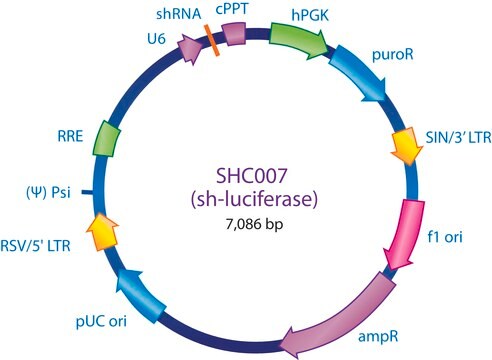Recommended Products
Quality Level
form
liquid
technique(s)
capture ELISA: 106 VP/mL using p24
shipped in
dry ice
storage temp.
−70°C
Looking for similar products? Visit Product Comparison Guide
General description
Custom Cloning - Now with TurboGFP™
There may be times when classic drug selection for stable or semi-stable cell lines is not possible or desired. In addition, orthogonal methods of selection from puromycin may be required for the expression of multiple shRNAs or expression of shRNA concomitant with transgene expression.
We now offer vectors containing tGFP as a solution to these problems. This vector maintains all of the other elements of the pLKO.1 vector, but the puromycin resistance gene has been replaced by TurboGFP. Our MISSION bio-production team will customize the vector with either a TRC shRNA sequence or your favorite shRNA sequence. With TurboGFP in the vector, FACS and fluorescence microscopy techniques allow for rapid estimation of transduction efficiency and automated, rapid selection of cell populations that stably express the shRNA. Selection by GFP provides an orthogonal method when cells already stably express puromycin resistance. In addition, we also offer pLKO.1-puro-CMV-tGFP. With this vector, you can choose between GFP and puromycin selection, all with the shRNA expression vector.
For selection by a second class of antibiotics, we offer vectors containing the neomycin resistance gene. These two vectors are pLKO.1-hPGK-Neo and pLKO.1-CMV-Neo. Stable shRNA integrants can be found by selecting in G418 (Product Number A1720). As with puromycin, a cytotoxicity profile for your particular cell line will need to be generated. As an example, see the puromycin protocol, but utilize G418 instead of puromycin. As a starting point, 1 mg/mL of G418 has been utilized for selection of shRNA constructs in A549 cells.
The service includes cloning, sequencing, DNA preparation (500 ng) and lentiviral preparation (200 μl at 1 x 106 VP/mL, minimum titer via p24 assay). The DNA and viral preparations are available to be shipped 4-6 weeks from the time the order is placed. For ordering, visit our custom shRNA ordering page or contact our sales representative.
Large-Scale and High Titer Lentiviral Particles
We have a versatile manufacturing platform for high-throughput or large-scale viral production of most HIV-1-based lentiviral vectors. The standard format of the MISSION TRC shRNA collection is 200 μl of 1 x 106 VP/mL (via p24 assay) minimum titer. Any clone, target set, or control can be produced at larger volumes with the same minimum titer specification or higher titers. Our highest titer option is 109 VP/mL. We also accommodate large-scale and high titer viral preparation using clones you send to us (must be compatible with our system). Our robust and optimized processes will save you time and reduce variability in your transduction experiments. To review pricing or to submit a request for a quotation on your specific project, please use our MISSION Custom Request Submission Form.
Other Notes
Legal Information
Storage Class Code
12 - Non Combustible Liquids
WGK
WGK 3
Flash Point(F)
Not applicable
Flash Point(C)
Not applicable
Choose from one of the most recent versions:
Certificates of Analysis (COA)
Sorry, we don't have COAs for this product available online at this time.
If you need assistance, please contact Customer Support.
Already Own This Product?
Find documentation for the products that you have recently purchased in the Document Library.
Customers Also Viewed
Articles
MISSION shRNA reduce the expression of specific target genes by targeting the specific mRNA therefore reducing the corresponding protein expression.
Our team of scientists has experience in all areas of research including Life Science, Material Science, Chemical Synthesis, Chromatography, Analytical and many others.
Contact Technical Service








